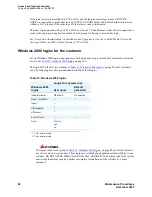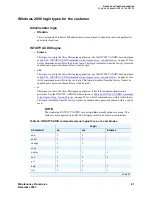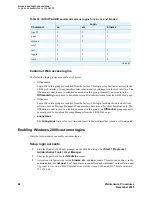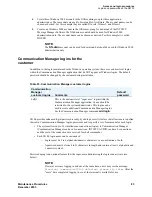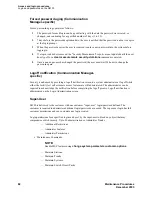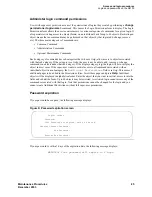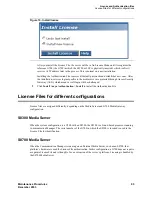
Access and login procedures
Logins and passwords on the S8100
Maintenance Procedures
79
December 2003
To access Device Manager
1
Open a compatible Internet browser on your computer. Currently this includes Internet Explorer
5.0 (or higher) and Netscape Navigator 4.7 and 6.2. The Java Plug-in 1.2.2 or 1.3.1 is required.
2
In the Address (or Location) field of your browser, type the IP address or name of the Layer 2
Switching Processor and press Enter.
•
If the network includes a domain name service (DNS) server that has been administered
with this IP device’s name, you can type the processor's name into the address field
instead of the IP address. For example,
http://P330-stack1.mycompany.com
NOTE:
The Device Manager is not available through the S8300 Media Server. You must be
connected to either the Layer 2 Switching Processor or G700 Media Gateway processor
through the corporate LAN.
3
A GUI rendering of the stack devices appears. Proceed with Media Gateway or stack device
administration.
Logins and passwords on the S8100
This section describes passwords and logins on the S8100 system.
This chapter provides information about the setup and use of customer logins:
•
•
Windows 2000 logins for the customer
•
Windows 2000 login types for the customer
•
Enabling Windows 2000 customer logins
•
Communication Manager logins for the customer
Customer access
In S8100, the Lucent Access Control (LAC) module allows access to a “shell” (also called “bash”) using
any valid Windows 2000 login. This enhancement allows a customer to use a login, such as NTADMIN,
to access Windows 2000 via a “bash shell”. This feature is not intended to be used by Avaya Services
personnel who continue to use the Lucent Services logins (lucent1, lucent2, lucent3).
In S8100, the LAC module listened only on TCP port 23. A connection to this port produced different
results depending on the login used. For example, a services login (lucent1, lucent2, lucent3) resulted in
the “lac” prompt to select Communication Manager, INTUITY AUDIX, or a Bash shell. An alias login,
such as dinit, resulted in a Communication Manager SAT screen without a LAC prompt. This continues
to be supported in S8100, but is being deprecated in favor of the use of separate telnet ports for direct
access to Communication Manager and INTUITY AUDIX.
If the telnet session is established to TCP port 22, and the login has privileges to access Communication
Manager, a connection is made directly to a Communication Manager SAT without a LAC prompt. If the
caller logs off, the telnet session is terminated.
Summary of Contents for CMC1
Page 1: ...Maintenance Procedures 555 245 103 Issue 1 1 December 2003 ...
Page 14: ...Contents 14 Maintenance Procedures December 2003 ...
Page 416: ...Additional maintenance procedures IP Telephones 416 Maintenance Procedures December 2003 ...
Page 426: ...Index X 426 Maintenance Procedures December 2003 ...
















